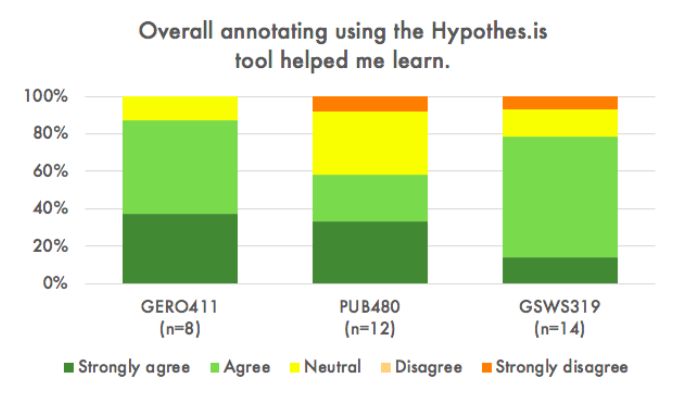Comment, reply, repeat: Engaging students with social annotation

By Alice Fleerackers, Juan Pablo Alperin, Esteban Morales, and Remi Kalir
Picture the last time you sat down to read an article for class. If your university experience was anything like most students’, chances are, you were alone.
While solitary reading has benefits and is a common aspect of learning in higher education, it may not be the most effective way to read. Research suggests that social annotation (SA) tools—which allow students to highlight and comment on digital course materials as they read—have impressive educational benefits. SA tools can help with students’ reading comprehension, peer review, motivation, attitudes toward technology, and much more.
But how does SA help students learn? To find out, we introduced the SA tool Hypothesis into three different undergraduate courses at Simon Fraser University: one in Gerontology, one in Publishing, and one in Women, Sexuality & Gender Studies. Together, students created more than 2,000 annotations atop more than 250 course readings over the course of a semester—all of which we collected and coded for evidence of learning. We also asked students about their experiences with the tool in an online survey at the end of the semester; 33 students across the courses completed our survey.
The outcomes of our research were thought-provoking and inspiring—and we’re eager to publish the full results soon. But for now, we’re sharing a sneak peek of the preliminary findings, right here on the ScholCommLab blog:
Social annotation helps (most) students learn
Overall, students in all three courses agreed that Hypothesis was a useful tool for learning. More than 70% reported that it helped them learn. Over 70% said it helped them understand other points of view, and more than 65% said it encouraged them to think about the course content outside of the classroom.
“I think annotations should be incorporated into every class with weekly course readings! It ensures that students are thoroughly reading course material and coming to class with a decent understanding of the week’s material.”

We also saw evidence of learning in the annotations themselves. When we analyzed each comment and question left by the students for different forms of learning, we found that students in all three courses relied on the tool for interpretation, using Hypothesis to draw hypotheses or conclusions, summarize information, or suggest problem solutions. Elaboration activities, like defining difficult terms or connecting ideas with examples, were also common, followed by questioning and clarifying activities.

Social annotation helps students feel connected
Using Hypothesis also made it easier for students to build community within their courses. More than 60% said annotating helped them feel connected to their peers, and almost 70% said it increased the amount of interaction they had with others in the class.

These social benefits may have been especially important for shy students, as well as those for whom English was a learned language:
“I am quite introverted and shy so speaking out in class is very intimidating. Engaging with classmates online and through annotations allowed me to contribute to class discussions.”
Formal incentives inspire students to annotate
Overall, students in all three courses were positive about their experience with Hypothesis, but when asked why they annotated, students offered up a diverse array of responses. For example, some said they annotated for personal learning, using Hypothesis as a way to prepare for essays or exams. Others said they were motivated by social reasons—using annotations as a way to connect with their peers:
“I like the idea of talking with my classmates and working through ideas together. Reading multiple interpretations of different ideas also adds diversity.”
But although many students listed many different reasons for annotating, motivations like “Participation marks” or “It was required for my class” were by far the most common. No matter how much students enjoyed using Hypothesis, our results revealed that the importance of formal incentives cannot be underestimated.
The instructors who took part in this study seemed to acknowledge this, too. All three chose to incentivize annotations in some way, either by offering bonus marks for completing weekly annotations, or by using a detailed grading rubric.
How can educators use SA tools to support student learning?
So where does this leave us? Together, our results reveal that SA tools and practices can play an important role in many university courses. By creating a space for discussion within the course readings themselves, SA tools like Hypothesis can help students learn, share ideas, understand new perspectives, and feel connected with one another.
But our findings also suggest that these benefits are only possible when annotations are formally incentivized. Although students themselves acknowledge the benefits of annotating, grades and participation marks remain their top motivation for doing so. To help spark interest in annotation, instructors need to provide clear guidelines that reward high quality contributions.
For an example of how to grade social annotations, check out this marking rubric by Dr. Sharon Koehn. To find out more about this ISTLD Dewey Fellowship-funded research, sign up for the ScholCommLab’s newsletter or watch Juan Alperin’s #ianno19 presentation:
4 Comments
Comments are closed.
[…] increased reading comprehension and motivation to do reading assignments, for example. More recent research, which has been written up preliminarily, has also found social annotation tools and practices help build not only better learning, but an […]
[…] reading Comment, reply, repeat: Engaging students with social annotation – Scholarly Communications Lab on the ScholCommLab […]
[…] Hypothesis is a tool like Perusall that you can use for annotating websites. A recent blog post, “Comment, reply, repeat: Engaging students with social annotation,” by Alice Fleerackers, Juan Pablo Alperin, Esteban Morales, and Remi Kalir on their experiences is available here. […]
[…] motivation, reading comprehension, and more. And students seem to like them: our lab’s research suggests they see these tools as useful for learning and for building community in the […]